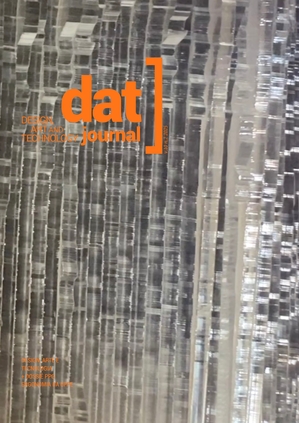Subverting User Experience
An experiment to feeling through network from the perspective of Strategic Design
DOI:
https://doi.org/10.29147/datjournal.v10i2.892Keywords:
Experimentation in Strategic Design, Speculative Design, Feeling through Network, User ExperienceAbstract
This article investigates the practice “Subverting the Network,” an experiment in Strategic Design focused on the OLX platform. Developed in an academic context, the methodological steps applied were: engaging in a project situation and prototyping spaces for debate. Unexpectedly, the project contrasted with the concept of User Experience (UX), revealing the weaknesses of the interface’s interaction capability in the realm of feeling. The theoretical-methodological and narrative shifts made in the article aim to discuss a priori the concepts of UX and Feeling in Network. The narrative of the experiment highlights the system’s insensitivity to aesthetic and affective exchanges, critiquing the anthropocentric approach and the rhetoric of technical neutrality in interface design. The article concludes that the practiced design is situated and not generalizable, but proposes an openness in the design of digital platforms towards the sensitive dimension – a hybrid feeling engendered in an ecological sensitivity between humans and non-humans.
Downloads
References
AMSTEL, Frederick M.C. van. Preconceitos da interface humano-computador. XVI Simpósio Brasileiro sobre Fatores Humanos em Sistemas Computacionais. Joinville, 2017.
BARAUNA, Debora. Sentir em rede: temática de projeto 2021. Disponível em: https://ppgdesign.wixsite.com/expemde/post/sentir-em-rede. Acesso em 12 de maio de 2024.
CHAVES, Iana Garófalo; BITTENCOURT, João Paulo; TARALLI, Cibele Haddad. O design centrado no humano na atual pesquisa brasileira-uma análise através das perspectivas de Klaus Krippendorff e da Ideo. HOLOS, v. 6, p. 213-225, 2013. DOI: https://doi.org/10.15628/holos.2013.1560
DI FELICE, M. Net-ativismo: da ação social ao ato conectivo. São Paulo: Editora Paulus, 2017.
DANESE, João; FERREIRA, Marcelo. Relações entre experiência do usuário e design emocional na interação humano computador. Arcos Design. p. 46-61, 2021. DOI: https://doi.org/10.12957/arcosdesign.2021.51952
DUNNE, Anthony; RABY, Fiona. Speculative everything: design, fiction, and social dreaming. MIT press, 2013.
FRANZATO, Carlo. O princípio de deslocamento na base do metadesign. In: 11º Congresso Brasileiro de Pesquisa e Desenvolvimento em Design. p. 1187-1196, 2014. DOI: https://doi.org/10.5151/designpro-ped-00178
GAVER, William. What should we expect from research through design? In: Proceedings of the SIGCHI conference on human factors in computing systems. p. 937-946, 2012. DOI: https://doi.org/10.1145/2207676.2208538
GASSON, Susan. Human-centered vs. user-centered approaches to information system design. Journal of Information Technology Theory and Application (JITTA), v. 5, n. 2, p. 5, 2003.
HARAWAY, D. Artigos saberes localizados: Cadernos Pagu, v.5, p.07–41, 1995.
HAGGARD, Patrick; CLARK, Sam; KALOGERAS, Jeri. Voluntary action and conscious awareness. Nature neuroscience, v. 5, n. 4, p. 382-385, 2002. DOI: https://doi.org/10.1038/nn827
LATOUR, Bruno. Reagregando o social: uma introdução à teoria Ator-Rede. Salvador: Edufba, 2012.
MAGALHÃES, M. Sentir em rede: net-ativismo estético na ação colaborativa Letters to the Earth. PÓS: Revista do Programa de Pós-graduação em Artes da EBA/UFMG. v.9, n.18, nov.2019. DOI: https://doi.org/10.35699/2237-5864.2019.16117
MAINSAH, Henry; MORRISON, Andrew. Towards a manifesto for methodological experimentation in design research. Nordes, v. 1, n. 5, 2013. DOI: https://doi.org/10.21606/nordes.2013.016
MEYER, G. A Experimentação como Espaço Ambivalente de Antecipação e Proposição de Controvérsias. Revista Estudos em Design. Rio de Janeiro: v.26, n.1, p. 29–47. 2018.
NORMAN, D. Things that makes us smart: defending human attributes in the age of the machine. USA: Perseus Book, 1993.
NORMAN, D. A. Emotional design: why we love (or hate) everyday things. Nova Iorque, NY: Basic Books, 2004.
NORMAN, D.; VERGANTI, R. Incremental and radical innovation: design research versus technology and meaning change. Design Issues, v. 30, n. 1, p. 78-96, 2014. DOI: https://doi.org/10.1162/DESI_a_00250
PERNIOLA, M. Do Sentir. Lisboa: Editorial Presença, 1993.
SCHLEMMER, Eliane; MORGADO, Leonel Caseiro; MOREIRA, José Antonio Marques. Educação e transformação digital: o habitar do ensinar e do aprender, epistemologias reticulares e ecossistemas de inovação. Interfaces da Educação, v. 11, n. 32, p. 764-790, 2020. DOI: https://doi.org/10.26514/inter.v11i32.4029
SEINFELD, Sofia et al. User Representations in Human-Computer Interaction. Human–Computer Interaction, p. 1-39, 2020.
Downloads
Published
How to Cite
Issue
Section
License
Copyright (c) 2025 DAT Journal

This work is licensed under a Creative Commons Attribution 4.0 International License.


























